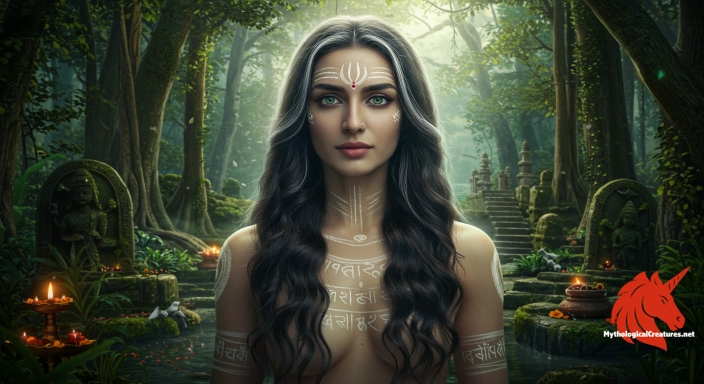Astris: Astris, also known as Asteria, is a divine figure in Greek mythology and one of the Heliades, daughters of Helios.

Astris
Astris - Her myth illustrates the intermingling of Greek and Indian traditions, linking the divine realm of the sun with the terrestrial lineage of Indian royalty.
Origins & First Encounters
Astris, also known as Asteria, emerges as a luminous figure woven into the fabric of Greek mythology, marked by an illustrious celestial heritage.
Her origins lie in the tradition of the Heliades, the radiant daughters of Helios, a lineage that imbues her tale with a distinct solar splendour.
Her first attestation in ancient literature appears in the epic Dionysiaca by Nonnus, where her divine ancestry and complex relationships are vividly portrayed.
Some traditions state that her father is Helios and her mother an Oceanid such as Clymene or Ceto, a detail that situates her at the intersection of light and water.
The myth delicately balances elements of the ethereal and the earthly, as her union with the river god Hydaspes underscores a bridging of domains.
This matrimonial connection not only enriches her narrative but also introduces an inter-cultural link that extends from the Greek world to the regions surrounding the modern Jhelum River.
The birth of her son, Deriades, who would become a king in far-off lands, adds a further dimension of cross-cultural integration to her story.
The amalgamation of divine radiance with terrestrial influence in her myth speaks to broader themes in ancient storytelling, where the gods often overlap with natural forces.
Source Texts & Tale Variants
The principal source that brings Astris to light is Nonnus’s Dionysiaca, an expansive composition that celebrates the interplay between the divine and mortal realms.
This epic text is instrumental in shaping our understanding of her role within the divine family of Helios and the Heliades.
Additional fragments from later periods, though not as extensive, hint at alternative traditions and subtler nuances in her portrayal.
Some literary commentators and later scholiasts offer variant readings that enrich the myth by aligning her character with broader themes found in mythical genealogies.
These sources often blend astronomical imagery with the narrative of river deities, thereby reinforcing her dual connection to sky and water.
Though the surviving texts are limited, the echoes of her myth resonate through the layered interpretations in Byzantine and medieval commentaries.
Over time, oral traditions have subtly augmented her character, adding dimensions that bespoke evolving cultural narratives.
This mosaic of sources, both written and oral, demonstrates the flexibility and enduring appeal of her myth in various historical contexts.
Form & Powers
Artistic depictions of Astris often evoke an ethereal beauty that reflects her celestial origins intertwined with hints of terrestrial grace.
Her imagery is typically marked by luminous eyes and flowing hair that is said to shimmer like threads of gold or silver, catching the essence of both dawn and dusk.
Some portrayals suggest that she is adorned with an intricate diadem, a visual echo of her connection to the radiant power of Helios.
The contours of her figure are rendered with a graceful elegance that straddles the line between mortal form and divine effulgence.
Her garments, often depicted as light and flowing, merge seamlessly with the natural surroundings, symbolising an intrinsic link with both the skies and the water.
Despite the scarcity of direct physical descriptions in ancient texts, later artistic reinterpretations have consistently highlighted her otherworldly glow and refined stature.
Each representation tends to encapsulate the delicate balance between strength and vulnerability, a theme common to many minor deities in classical mythology.
This convergence of aesthetic qualities serves to reinforce her status as a figure of both celestial and natural harmony.
Regional Faces
Astris’s myth exhibits intriguing regional adaptations that reflect the cross-cultural exchanges between the Greek world and neighbouring traditions.
While her origins are squarely rooted in Greek mythological narratives, her marriage to Hydaspes naturally localises her story within the landscape of the modern Jhelum River.
This geographical shift hints at an ancient process of myth-making where local deities and natural phenomena were integrated into the classical pantheon.
In regions close to the Indus basin, elements of her myth were reinterpreted to resonate with established cultural beliefs about river deities and fertility rites.
Local variations often emphasise her role as a progenitor, linking the divine with rulership and the natural bounty of the land.
Furthermore, adaptations in art and literature have introduced regional iconographies that merge Greek motifs with indigenous symbolism.
Such intertwining of cultural narratives underscores the fluidity with which myth travelled across borders and evolved with local tastes.
This regional reimagining not only broadened her mythical narrative but also enriched the diversity of ancient myth-making practices.
Cultural Parallels
The narrative of Astris invites comparative exploration with several other mythic figures whose stories blend celestial origins with earthly presence.
Her divine ancestry bears resemblance to other solar deities and nymphs in Greek myth, linking her symbolically with figures such as the Titaness Asteria and other minor manifestations of light.
The motif of uniting the heavens with the earthly realm is a recurring theme in myths around the world, and Astris’s marriage to a river god is emblematic of such symbolic unions.
This theme is echoed in various cultures where water and light are intertwined, reflecting universal ideas of renewal, fertility, and cosmic balance.
Her narrative shares affinities with traditions found in both Greco-Roman and Eastern mythologies, where the merging of distinct natural forces is celebrated.
Comparative analysis reveals that, like many mythic hybrids, she serves as a conduit for broader cultural values linking divinity with nature.
Her story also resonates with the archetypal image of a nurturing figure whose lineage and marital choices symbolically bind disparate realms.
Such cross-cultural parallels underscore the shared human fascination with producing myths that explain the convergence of the tangible and the transcendent.
In this way, Astris’s tale not only stands firmly within the Greek mythic tradition but also aligns with a global tapestry of interwoven celestial and terrestrial narratives.
Legacy & Modern Evolution
Over the centuries, the figure of Astris has evolved from a relatively obscure character in a classical epic to an emblem of cultural synthesis and enduring mystique.
Late antique and medieval reinterpretations of her myth often highlighted her dual connections to both celestial radiance and riverine vitality, thus reinforcing her adaptable nature.
As artistic and literary traditions evolved, her image was progressively adapted in ways that underscored her role as a mediator between disparate cultural landscapes.
Modern scholarship and creative reinterpretations have rediscovered Astris as a symbol of transcultural dialogue, reflecting both Greek mythic heritage and Eastern influences.
Contemporary artistic renderings and literary works often incorporate themes from her narrative to explore ideas of transformation and the delicate interplay between nature and divinity.
This modern legacy is enhanced by a growing academic interest in how minor mythological figures can encapsulate broader cultural exchanges and enduring aesthetic values.
The visual and narrative shifts observed in depictions of Astris highlight the dynamic evolution of myth over time, adapting to new cultural contexts while retaining its ancient core.
Her story continues to inspire a sense of wonder and debate, testifying to the timeless appeal of classical mythology in modern creative and scholarly circles.
Ultimately, Astris has transcended her original mythic context to become a multifaceted symbol that bridges the divide between historical tradition and contemporary imagination.
Interesting Fact
Astris is unique among mythological figures for her role in linking Greek and Indian traditions, exemplifying an early instance of cultural synthesis in ancient lore.
Quick Creature Info
Origin:
Associations:
Our Mythic Legendary Rating:

Also Sometimes Known As:
Habitat:
Supernatural Powers:
Physical Attributes:
Abilities:
Behavior:
Lore:
Related Creatures, Tales or Lore
- PPhaethusa
- LLampetia
- AAegiale
References
Discover Another Mythical Legend You May Not Have Heard Of?
Uncover the mysteries of ancient folklore and expand your knowledge of legendary beings from cultures around the world.
Dare to Meet the Diti....
Mythical Disclaimer: The images and data on this site are derived from various historical and literary sources, but we have found that many myths often have multiple versions and interpretations across references, sometimes contradictory. As a result, these creature depictions are artistic interpretations—imaginative blends of folklore, legend, and a dash of AI guesswork. Because creature descriptions vary widely, our illustrations and accompanying information represent our best effort to honor mythology while bridging creative gaps. Enjoy these interpretations—just remember, we've done our best to respect the stories and validate available data, but in the realm of mythology, details often shift, imagination leads the way, and nothing is ever set in stone!
Curated by the Mythological Creatures Team (rev. May 2025)
